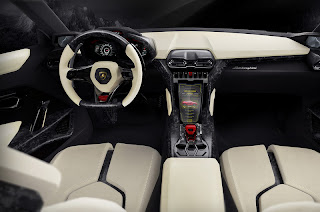4/27/12
4/22/12
2013 Audi Q5
Visually, the 2013 Q5 sports Audi's new six-point front grille accompanied by revised headlamp fixtures and a slightly redesigned front bumper, while at the back we find tweaked tail lamp graphics and a modified rear apron.
The changes on the inside are even more discrete and concern the more premium trim and the new steering wheel designs.
From what we know, under the skin, the Q5 will benefit from a refined chassis with changes to the suspension and a renewed and more fuel-efficient engine lineup that will include Audi's supercharged 3.0-liter TFSI which is offered in various states of tune.
Seat Ibiza Cupra
4/22/2012
Beijing, Bejibg Motor Show, CHINA AUTO SHOW, CONCEPTS, Cupra, Seat, SEAT CONCEPTS, Seat Cupra, SEAT IBIZA, Seat Ibiza Cupra
No comments
The Cupra model adopts the new face with the wider front grille of the regular Ibiza facelift that we saw at the Geneva Motor Show in March, adding several sporty touches such as the bespoke front bumper with the wider lower grille, LED headlamps and larger alloy wheels.
The three-door hatch also gets gloss black mirrors and a rear apron that integrates a diffuser and a central trapezoidal exhaust.
Inside, the improvements are similar to the rest of the range and include the use of higher quality materials and a new climate control display, plus a redesigned three-spoke sports steering wheel and instrument panel.
We don’t expect any changes to the Ibiza Cupra's driveline that links a 178hp (180PS) 1.4-liter supercharged and turbocharged four-cylinder petrol engine to a seven-speed DSG transmission and XDS electronic differential lock, which drive the front wheels.
Legendary Formula 1 Cars
4/22/2012
Cars, CLASSICS, F1, Ferrari, Formula 1, Legendary, Legendary Formula, Legendary Formula 1 Cars, Lotus, RACING, RED BULL, REPORTS
No comments
Sharknose: Ferrari 156
1961 saw the debut of a car that would become one of the most distinctive and beautiful racing Ferraris of all time. With its unmistakable twin nostril air intake, the Carlo Chiti designed 156 was known simply as the Sharknose Ferrari.
Although Enzo Ferrari had famously dismissed rear-engined Formula 1 cars stating “The horses pull the car rather than push it,” he finally gave into the idea starting in 1960, when Richie Ginther drove theScuderia’s first rear-engined machine to a less than stellar sixth place finish at the Monaco Grand Prix.
The 156 came a year later and was considerably more successful. In a season that consisted of only eight races, the Ferrari 156 took home five victories as well as both the driver’s and constructor’s championships. Sadly, the year was also marred by tragedy when Ferrari driver Wolfgang von Trips was killed at the Italian Grand Prix along with fifteen spectators.
The events of that horrific September afternoon along with Ferrari’s 1961 season are remembered in the 1996 movie “La Passione”, which tells the story of a boy and his love for the scarlet cars.
Because Enzo Ferrari always wished to look to the future of his company and never dwell upon the past, all of the original Sharknose Ferraris were destroyed after the 1963 Formula 1 season when they ceased to be of use to the team.
In order to film scenes for “La Passione”, the film’s writer, Chris Rea, commissioned a replica of the fabled Ferrari, bringing life to this iconic piece of Formula 1 history once more.
The Bathtub: Lotus 25
Those who follow Formula 1 will be more than familiar with the name Adrian Newey. Renowned for being the most talented designer of his generation, it seems as though whatever Newey touches turns into gold.
In his day, Colin Chapman was similarly famous for his innovative designs and being ahead of his time. In 1952, Chapman created one of the most recognised companies in motor racing history when he founded Lotus Cars.
In the early 60s, while having lunch with chassis designer Frank Costin, Chapman drew sketches on a napkin for the car that was to give Team Lotus its first ever World Championship and launch the team into an era of success that most constructers can only dream of.
The Lotus 25 made its racing debut in 1962 and featured a stiff monocoque chassis that was also very light. The car was often referred to as the Bathtub because of its tub-like appearance and its drivers had to lie back sharply behind the wheel.
The hugely successful car was used in the 1962, 1963, 1964 and 1965 World Championships respectively and won a total of fourteen races, including two driver’s championships and two constructor’s championships.
Black Beauty: Lotus 79
Continuing Colin Chapman’s tradition of success was a revolutionary car that took the world by storm in 1978. The Lotus 79, which was both stunningly beautiful and blindingly fast, quickly earned itself the nickname “Black Beauty” because of its black and gold livery.
After pioneering ground effects the previous year, Team Lotus finally perfected the concept with the Lotus 79 and the result was a car that gripped the road better than any of its rivals. The 79 dominated the 1978 Formula 1 season, taking six victories and securing both the driver’s and constructor’s championships.
The chassis was also used during parts of the 1979 Formula 1 season and has since gone down in history as one of the most innovative cars of all time. It is credited for launching Formula 1 into the aerodynamics era and is featured frequently on lists of the most beautiful racecars.
In 1986, Gordon Murray was desperate to revive the days of Brabham’s glory and decided that something radical had to be done to gain advantage over the team’s rivals Williams and McLaren.
The result was the Brabham BT55, a car that was so low to the ground that it forced drivers Riccardo Patrese and Elio de Angelis to lie down almost horizontally in the cockpit.
Its height off the ground led to the car becoming known as the Skateboard, the Roller Skate and even the Flat Fish. Although the car produced plenty of downforce, it also created drag making the BT55 uncompetitive.
The iconic car, which took Ayrton Senna to his first World Championship dominated the season, winning all but one race in 1988. In addition to this, it is credited for making the lying down position fashionable once more in Formula 1.
Kate’s Dirty Sister: Red Bull RB5
Kate’s Dirty Sister is the odd one out in this list of iconic cars and their nicknames because it was not the name that was given to every Red Bull RB5 ever produced, but rather the nickname given to one particular chassis driven by Formula 1 World Champion, Sebastian Vettel.
The young German, who is known for celebrating his victories with an index-fingered salute, has gotten into the habit of giving his cars female names. Vettel’s ‘ladies’ have had names like Julie, Luscious Liz and most recently Abbey but out of all of the nicknames, Kate’s Dirty Sister is certainly the most amusing.
It all started in 2009 when Vettel’s first RB5 chassis, which he had lovingly christened Kate, was involved in a major shunt at the first Grand Prix of the season. Ruined beyond repair, Sebastian was forced to replace Kate with an updated model, one that was a little bit different to her older sibling.
Sebastian Vettel is just one of several drivers who talk to their cars as if they are human beings; coaxing them to the end of a race, paying homage to them in victory or even scolding them in defeat.
As fans, our emotions are also tied closely to the cars that we support and so it is little wonder that when one particular model catches our eye, we humanise it with a nickname.
Whether the name is intended to ridicule or to praise is of little importance. All that matters is the power that it has to invoke fond memories of years gone by and of the vehicles that defined them.
“My original car was called Kate.” Vettel confided after winning the Chinese Grand Prix. “But then it got smashed up in the opening race in Australia. So we called this one Kate’s Dirty Sister because it is more aggressive and faster.”
Together, Sebastian Vettel and the Adrian Newey designed chassis achieved a total of four wins together and took second place in the driver’s championship.
The 2009 season saw Red Bull emerge as a serious title challenger and the success of the RB5, which gave the team its very first victory, propelled Red Bull to back to back championships in 2010 and 2011.
4/21/12
Lamborghini Urus SUV Concept
4/21/2012
CHINA AUTO SHOW, CONCEPTS, Lamborghini, LAMBORGHINI CONCEPTS, Lamborghini SUV, Lamborghini Urus, Lamborghini Urus SUV Concept, SUV Concept
No comments
As is the tradition, the SUV's name is derived from the world of bulls. The Urus, also known as Aurochs, is one of the wild ancestors of domestic cattle. According to the Italian automaker, the Spanish fighting bull, as bred for the past 500 years, is still very close to the Urus in its appearance.
At 4.99 m long (196.5 inches), 1.99 m (78.4 inches) wide and 1.66m (65.4 inches) tall, the Urus is about 120mm longer and 16mm wider but also 30mm lower than a BMW X6.
Lamborghini has not yet specified the front-mounted engine, but it says it will have an output of 600HP and the lowest CO2 emissions in its class. Chances are a production model would be fitted with either a V10 or Audi's new V8 turbo, perhaps even both. Either way, the engine transmits its power to both axles via a dual-clutch gearbox and permanent four-wheel drive transmission with traction control.
The Urus uses the same platform architecture as the Bentley EXP 9 F study and the next generations of the VW Touareg, Porsche Cayenne and Audi Q7.
According to the company, the class-leading CO2 emissions target will be achieved thanks to the lightweight design philosophy not only in the chassis and bodywork, but the interior as well, through the use of what Lamborghini calls “innovative” carbon fiber technologies.
This offers the advantage of a low center of gravity, improving handling, another area where the Urus aims to beat its competitors. Since it’s an SUV, the off-roading part is taken care of not only by the AWD system but also by the variable height suspension and front spoiler and the good approach angle.
“The Urus is a very concrete idea for the future of Lamborghini – as a third model line and as the perfect complement to our super sports cars”, said Stephan Winkelmann, President and CEO of Lamborghini. “SUVs stand for freedom and emotion. SUVs make up one of the most successful market segments worldwide. The Urus is the most extreme interpretation of the SUV idea; it is the Lamborghini of the SUVs.”
It’s also the first modern Lamborghini that seats four instead of just two passengers and can be used as a family’s sole car. This, of course, while true, is mostly pure PR talk, just like the claim of the Charging Bull having an SUV history. First, it’s highly unlikely that any Lamborghini-owning family has only one car, and second, the LM002 sold a mere 300 units in its six-year long lifespan.
The truth is that the Urus’ mission is twofold: the first part is to convince the company’s customers to park a Lamborghini rather than a Range Rover next to their Murcielago/Gallardo/Aventador in their garage.
The second part is to significantly increase Lamborghini’s production. The bean-counters at the VW Group estimate that the SUV, which is targeted mostly at the USA, United Kingdom, Germany, Russia, the Middle East and China, can reach annual sales of around 3,000 units.


































































.jpg)




.jpg)


















